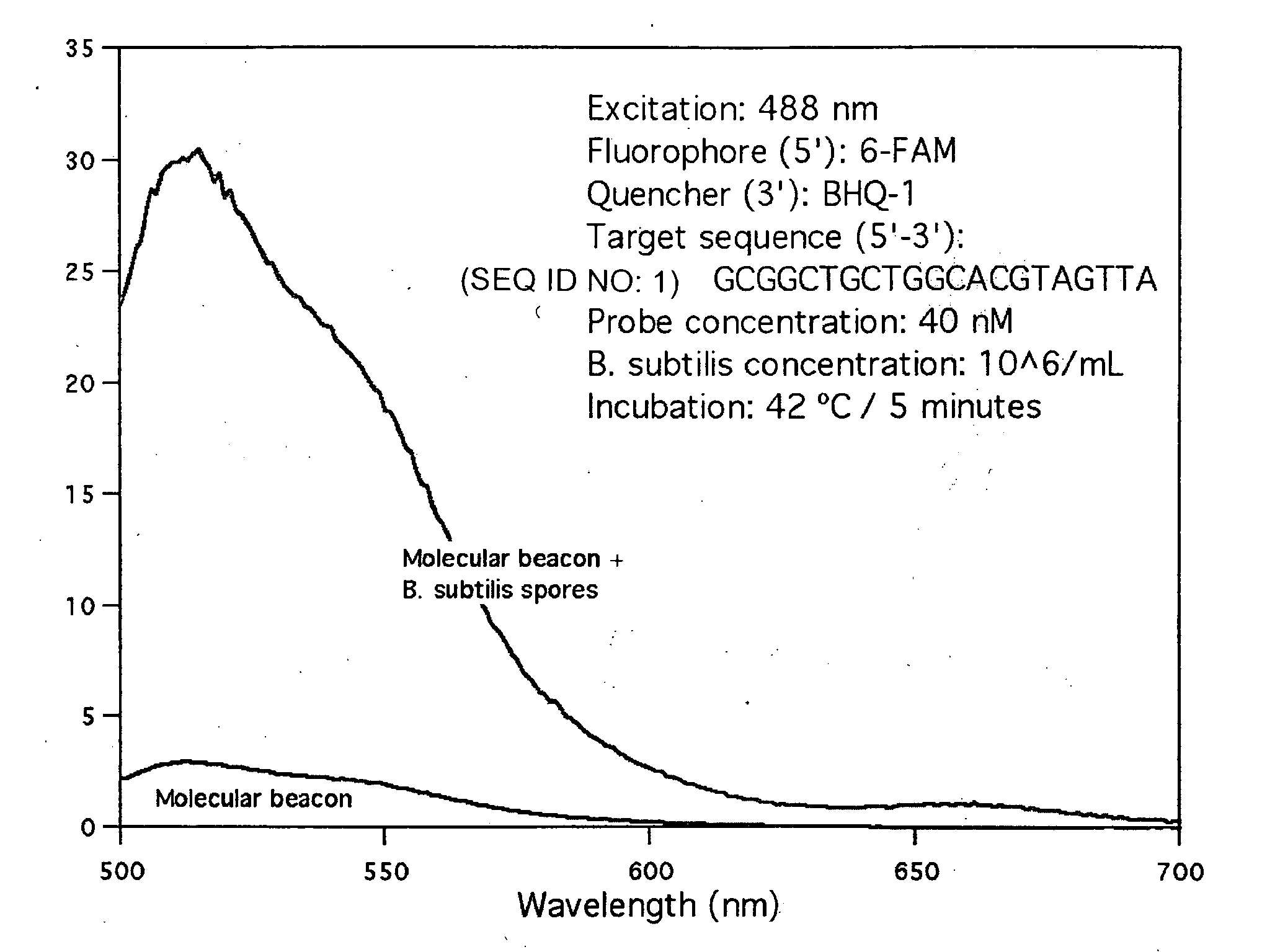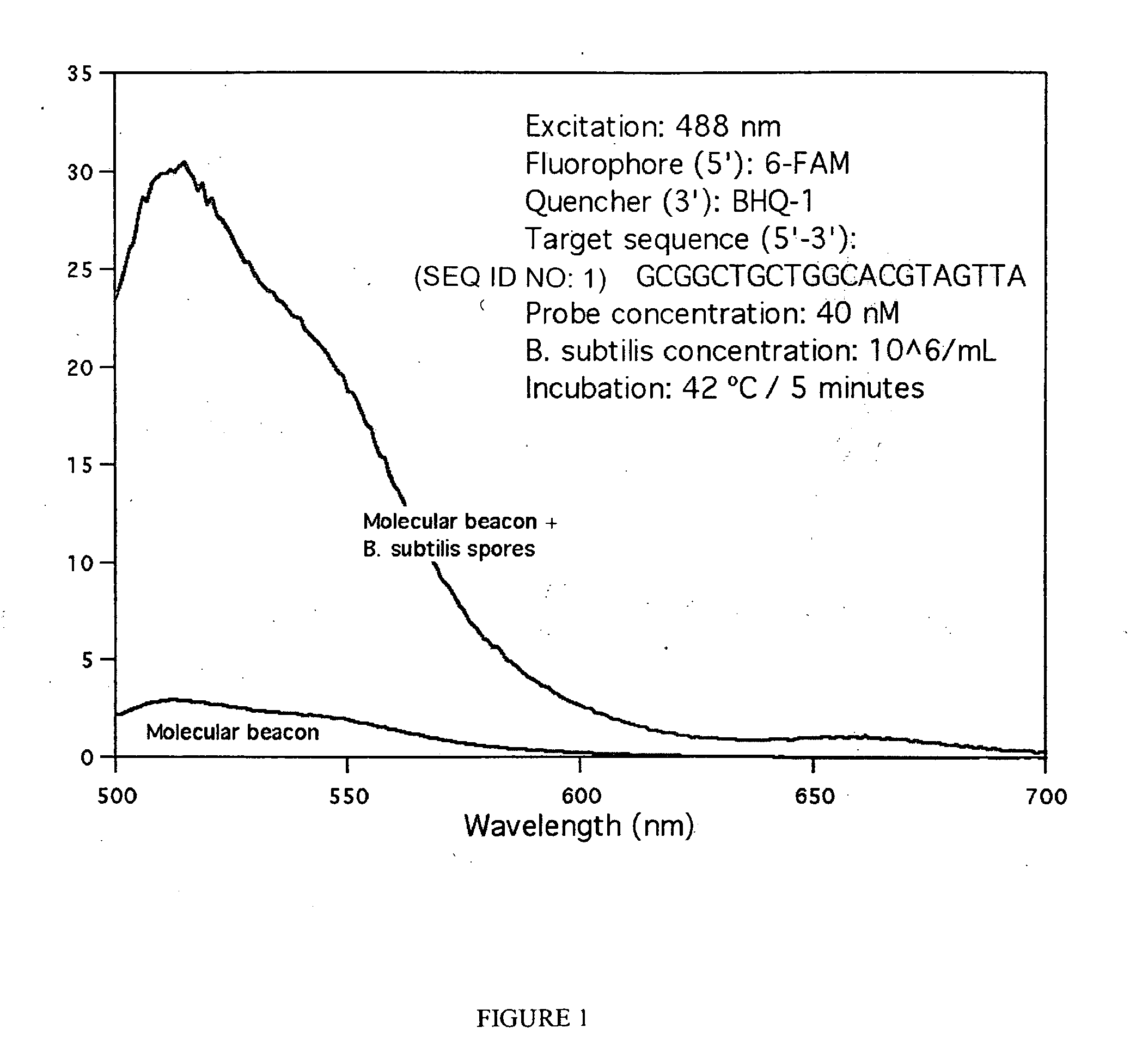Method for rapid identification and quantification of microorganisms
a microorganism and rapid technology, applied in the field of rapid identification and quantification of microorganisms, can solve the problems of limiting the usefulness of this method, difficult control of mrsa transmission within and between health care institutions, increased length of hospital stay, etc., and achieves high sensitive and quantitative, high selective
- Summary
- Abstract
- Description
- Claims
- Application Information
AI Technical Summary
Benefits of technology
Problems solved by technology
Method used
Image
Examples
example
Example 1
[0064]A molecular beacon with sequence 5′-CGCGATCTAACTACGTGCCAGCAGCCGCGATCGCG-3′ (SEQ ID NO: 24) that targets the rmH-16S gene of Bacillus subtilus was obtained from Sigma-Aldrich. The self-complementary stem sequence is shown undelined above. This molecular beacon is labeled with 6-carboxyfluorescein (6-FAM) at the 5′ end and with the quencher BHQ-1™ at the 3′ end. The molecular beacon was mixed with untreated Bacillus subtilis spores at a final concentration of 40 nM and 106 spores / mL respectively, in a final volume of 5 mL of standard Tris-EDTA buffer. After mixing, the mixture was incubated at 42° C. for about 5 minutes to ensure binding of the molecular beacon molecules to the specific-sequence target DNA molecules present on the surface of the spores.
[0065]The fluorescence spectrum of the hybridization mixture was obtained with a Shimadzu 1501 spectrofluorophotometer in a 1 cm quartz cell, using 488 nm excitation light. The spectrum is shown in FIG. 1, which also show...
example 2
[0067]Molecular beacons having the following sequences in Table 1 may be used in the procedure outlined in Example 1 to target the corresponding microorganism of interest. Note that the temperature to which the mixture is heated may vary according to manufacturer's instructions and to the knowledge available to one of skill in the art.
MicroorganismTarget GeneSequence (5′-3′)Methycillin-resistant StaphylococcusGCG GCT GCT GGC ACG TAG TTAaureus(SEQ ID NO: 1)Staphylococcus aureusorfXCCC GCG CGT AGT TAC TGC GTT GTA AGA CGT CCG CGG G(SEQ ID NO: 2)Methycillin-resistant StaphylococcusmecACGC GAT TTC AAT ATG TAT GCT TTG GTC TTT CTG ATC GCGaureus(SEQ ID NO: 3)Clostridium difficiletcdACAC GCG GAT TTT GAA TCT CTT CCT CTA GTA GCG CGT G(SEQ ID NO: 4)Acinetobacter baumannii16S-23S intergenicGCG GAT AGT GTG ATC TGA CGA AGA CAC ATT AAC TAT CGC Gregion(SEQ ID NO: 5)Vanomycin-resistant enterococcivanACGC GAT TCG ATG AGG GCG GAA AAC CCA ATA ATT ATC GCG(VRE)(SEQ ID NO: 6)Streptococcus pneumoniaelytACGC...
example 3
[0068]The following describes one example of a suitable sample collector, i.e. a bioaerosol detector.
[0069]A bioaerosol detector may be activated either manually or by means of a bioaerosol-detecting trigger. The sample collection plate comprises 96 individually addressable wells containing a thin layer of liquid silicone which aids in the collection of impacted particles. Particles greater then the filter cutoff size are deposited on the substrate. A standard filtration device or system could be used consisting of a filter or multiple filters. After collecting approximately 10-20 liters of air in one of the wells by means of a high efficiency DC diaphragm pump (70 liter.min. maximum flow), the well is treated with an appropriate composition comprising a suitable molecular beacon, as described in Examples 1 and 2, and fluorescence at the appropriate band is measured immediately by a two-axis positionable, miniaturized epifluorescence detector, such as those commonly found in microti...
PUM
| Property | Measurement | Unit |
|---|---|---|
| temperature | aaaaa | aaaaa |
| volume | aaaaa | aaaaa |
| diameter | aaaaa | aaaaa |
Abstract
Description
Claims
Application Information
 Login to View More
Login to View More - R&D
- Intellectual Property
- Life Sciences
- Materials
- Tech Scout
- Unparalleled Data Quality
- Higher Quality Content
- 60% Fewer Hallucinations
Browse by: Latest US Patents, China's latest patents, Technical Efficacy Thesaurus, Application Domain, Technology Topic, Popular Technical Reports.
© 2025 PatSnap. All rights reserved.Legal|Privacy policy|Modern Slavery Act Transparency Statement|Sitemap|About US| Contact US: help@patsnap.com


